Relation between Field and Potential
Relation between Field and Potential: Overview
This Topic covers sub-topics such as Electric Potential in Terms of Electric Field, Potential Difference in Uniform Electric Field, Potential Difference in Variable Electric Field in One Variable and, Electric Field from Potential in One Variable
Important Questions on Relation between Field and Potential
Choose the incorrect statement
(1)The potential energy per unit positive charge in an electric field at some point is called the electric potential.
(2) the work required to be done to move a point charge from one point to another in an electric field depends on the position of the points.
(3) the potential energy of the system will increase if a positive charge is moved against the Coulomb force.
(4) None of the above.
You are to bring two charges from infinity to the points represented by the potentials and in an electric field . If the distance between within the field is , find the total work done in assembling the configuration. Imagine an electric field in a space. The potential at the origin is zero. Find the potential at the point .
The potential of the field inside a charged sphere depends upon the distance from its centre the point under consideration in the following way: where and are constants If the charge is uniformly distributed within the sphere, then the value of is
From a point if we move in a direction making an angle & measured from axis, the potential gradient is given as . Find the direction and magnitude of electric field at that point.
If electric field strength at a point is zero at a given point, then what can you say about the electric potential at that point? Explain.
Gap between two electrodes of the spark- plug used in an automobile engine is
Magnitude of electric field between the electrodes is .Calculate the potential applied across the gap.
The electric potential in a certain situation is found to depend on only and is given by . Find the position on the axis where the electric intensity is zero.
Statement (A): Inside a charged hollow metal sphere, . (- electric field, -eslectric potential)
Statement (B): The work done in moving a positive charge on an equipotential surface is zero.
Statement (C): When two like charges are brought closer, their mutual electrostatic potential energy will increase.
A uniform electric field of is directed at with the positive -axis as shown in figure. If , then potential difference is
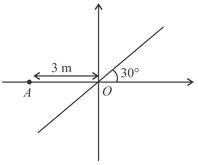
The electric field in a region is given by . The potential difference between the points and is i.e.,
Two infinitely long straight wires having linear charge densities and are separated by a distance (see figure). The potential difference is
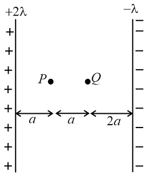
The variation of potential with distance is shown. Draw the corresponding with distance
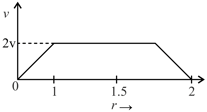
Find potential difference between and in an electric field
(a)
Electric field at a distance from given as . Then potential difference between the points situated at and .
A uniform electric field exists in plane. The potential of points and are and , respectively. The electric field is
In the figure shown, the electric field intensity at in is
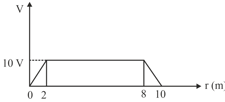
Distance between to identical plates charged oppositely is . The electron at the midpoint between the plates experience of a force of The potential difference between the plates is
When we calculate the expression of electric field of any shape we take at distance, so what do we mean by it and why cannot we take at distance?
A charge and the mass is projected from level ground with a velocity of at an angle of with the , horizontal ( direction). The electric potential in space is given by, . What is the speed of the charge (in ) when its , coordinate is maximum?
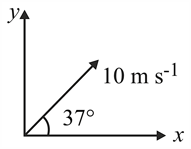
Two points and are at distances of and respectively from an infinite conducting plate having charge density . The work done in moving charge from to is
